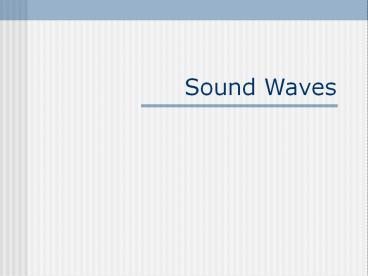Sound Waves PowerPoint PPT Presentation
Title: Sound Waves
1
Sound Waves
2
What You Already Know
- Principle of Linear Superposition
- When two or more waves are present simultaneously
at the same place, the disturbance is the
total of the from the individual waves. - Constructive Interference
- When two wave sources vibrate in , a
difference in path lengths that is zero or an
integer of leads to constructive
interference. - Destructive Interference
- When two wave sources vibrate in phase, a
difference in path lengths that is or a
half-integer of leads to destructive
interference.
3
The Nature of Sound
- Sound Waves
- Created by a object such as the string on a
violin, your vocal chords or the diaphragm of a
loudspeaker. - Sound waves can be transmitted through ,
and . - If there is medium, there is ____ sound.
4
How is Sound Transmitted?
- Sound is created by the collisions of and
such that it is transmitted through the bulk
matter.
5
Sound Wave Characteristics
- Condensation or Compression Region of the wave
where air is slightly . - Rarefaction Region of the air wave where the
is slightly . - Pure Tone A sound wave with a single .
- Pitch An objective property of sound associated
with . - frequency pitch.
- frequency pitch.
- Loudness The attribute of sound that is
associated with the of the wave. - Beat When two sound waves overlap with a
slightly different .
6
Speed of Sound
- Speed of sound depends on the through which
it travels. - ?kT
- m
- Where
- k Boltzmans constant (1.38 x 10-23
J/K) - ? Cp/Cv (5/3 for ideal monotonic
gases) - T Temperature (K)
- m Average mass of air (28.9 amu)
Air Water Steel
Speed (m/s)
7
Speed of Sound An Alternative View
- The speed of sound in other mediums may also be
represented by a mathematical relationship that
includes the density (?) and the bulk modulus (B) - Gases have a bulk modulus than liquids and
liquids have a bulk modulus than solids. - Hence, as the bulk modulus , the velocity .
8
Shift
- The change in sound frequency due to the relative
motion of either the source or the detector.
9
Doppler Shift
- fd fs(v vd)/(v - vs)
- Where
- v velocity of sound (343 m/s)
- fd frequency of the detector
- vd velocity of the detector
- fs frequency of the source
- vs velocity of the source
- If the source is moving the detector, vs is
. - If the source is moving from the detector, vs
is .
10
Waves in Musical Instruments
- Stringed instruments, such as the guitar,
piano or violin, and horn and wind instruments
such as the trumpet, oboe, flute and clarinet all
form when a note is being played. - The standing waves are of either the type that
are found on a string, or in an air column (open
or closed). - These standing waves all occur at
frequencies, also known as frequencies,
associated with the instrument.
11
Standing Wave Characteristics
- While a standing wave does not itself, it is
comprised of two waves traveling in
directions. - The series of frequencies where standing
waves recur (1f, 2f, 3f,). Where the first
frequency is called the first (1f), the
second frequency is called the second (2f),
and so on. - The first harmonic the first frequency (n
1). - The harmonic frequency 1.
12
Harmonics and Overtones of Standing Waves
13
Standing Wave Characteristics (cont.)
- The time for one wave to travel to the barrier
and back is - ______ ______ _____ _____
- For a string fixed at both ends with n
antinodes - fn n(v/2L) n 1, 2, 3,
- Each fn represents a or frequency
of the string. - Since ? v/f, the relationship can be rewritten
for ? as follows. - _____ _____
14
Longitudinal Standing Waves
- instruments, such as the flute, oboe,
clarinet, trumpet, etc. develop longitudinal
standing waves. - They are a column of .
- May be at one or both ends.
- Wave will back regardless as to whether or
not it is open or close ended.
15
Longitudinal Standing Waves Tube
- In an tube instrument like the flute, the
harmonics follow the following relationship - fn n(v/ L) n 1, 2, 3,
16
Longitudinal Standing Waves Tube on One End
- In a tube instrument like the clarinet or
oboe, the harmonics follow the following
relationship - fn n(v/ L) n 1, 3, 5,
17
Key Ideas
- Sound waves are generated by a object such as
the string on a violin, your vocal chords or the
diaphragm of a loudspeaker. - Sound waves can be transmitted through ,
and . - If there is no , there is no .
- Sound is generated by the cyclical of atoms
and molecules. - and denote portions of the wave that
are of slightly higher and lower pressure,
respectively.
18
Key Ideas
- Sound waves travel at different in different
mediums. - They up when going from air to a liquid to a
solid. - tone is sound of a single frequency.
- and are characteristics of sound that
represent its frequency and amplitude,
respectively. - When two sound waves overlap slightly due to
mildly different frequencies, they generate a
. - occur at multiples of the natural frequency.

